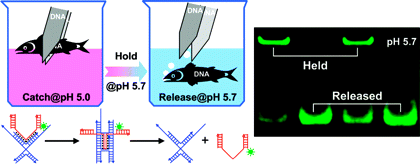Zhaoxiang Deng and colleagues note that other scientists have developed tweezers made of DNA, the double helix molecule and chemical blueprint of life. Those tweezers can open and close by responding to complementary chemical components found in DNA's backbone. However, getting the tweezers to grasp and release objects like real tweezers has remained a bioengineering challenge until now.

DNA tweezers. Credit: Journal of the American Chemical Society
The scientists describe development of a pair of DNA tweezers composed of four DNA strands — three which act as the "arms." In laboratory studies, the scientists showed that they could grab a piece of target DNA in the arms of the tweezers and release it on-demand using a controlled series of hydrogen bonding and pH changes. The scientists used fluorescent gel imaging to confirm the effectiveness of the tweezers' operation.
Article: Xiaogang Han, Zihao Zhou, Fan Yang, and Zhaoxiang Deng, 'Catch and Release: DNA Tweezers that Can Capture, Hold, and Release an Object under Control', J. Am. Chem. Soc., 130 (44), 14414–14415, 2008. 10.1021/ja805945r






Comments